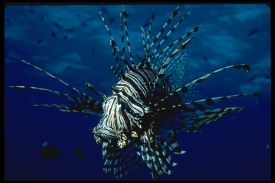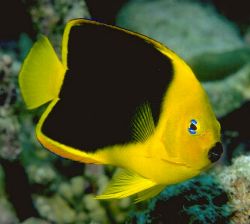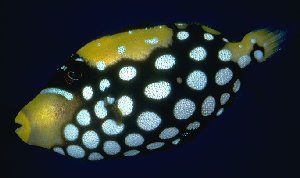 Just what constitutes a big tank? Obviously, if you've been used to keeping an 18"x12"x12" aquarium (not recommended for marines by the way) then obviously a three foot tank is going to seem relatively big. However, I would say that the realm of the truly big tank begins in the region 5'x18"x18". This represents 70 gallons gross gallonage of water and holds all the advantages, and the disadvantages, of a larger aquarium.
Just what constitutes a big tank? Obviously, if you've been used to keeping an 18"x12"x12" aquarium (not recommended for marines by the way) then obviously a three foot tank is going to seem relatively big. However, I would say that the realm of the truly big tank begins in the region 5'x18"x18". This represents 70 gallons gross gallonage of water and holds all the advantages, and the disadvantages, of a larger aquarium.
The Advantages
Clearly one of the biggest assets of this type of tank is that the choice and quantity of stock increases considerably. Big fish can be kept in abundance whilst looking at home in an uncramped atmosphere.
It has been known for many years that a larger quantity of water is far more stable, leading to slow and steady variations in pH and temperature. Unlike their smaller counterparts this increased stability usually results in fish and invertebrates that are far less stressed by rapid fluctuations of water quality and consequently tend to exhibit a healthier appearance and more natural behaviour patterns.
As anyone who has seen one will testify, big tanks are impressive sights. The bigger they are, the more impressive they get. Reef tanks really do look representative of the real thing and fish-only tanks can become a natural display of the 'fish melee' that is to be found in some areas of the world.
Both fish and invertebrates are more likely to reproduce in bigger volumes of water and this is an important point of conservation that we should pay particular attention to by studying and making known any relevant facts. By widening our knowledge in this way, the big tank owner can make a valuable contribution to captive breeding programmes.
The Disadvantages
Although there initially might appear to be a whole host of disadvantages in keeping a big tank, if proper advance preparation is made, only a few problems may be encountered later on.
A major consideration with any big tank is size and weight. An enormous aquarium can overpower a small room and can cause problems with excessive humidity (encouraging dampness) and unbearable heat from the lighting, especially on a hot summer day!
Water is also very heavy! A gallon of water weighs 8.5 lbs (3.86 kg), meaning that a 100 gallon tank will hold nearly 61 stones of water alone! Most solid concrete floors will support that sort of weight quite comfortably, but those in flats or with suspended wooden floors definitely need to seek professional advice before embarking on a project of this kind.
Most of the balance of disadvantages are directly related to cost. Big tanks do not come cheaply and costs may well escalate into thousands of pounds as filters, lighting, rockwork, salt and livestock are bought and taken into account.
The Big Decision 
There is no doubting the fact that the decision to install a big tank is going to be a major one. Everyone in the household should be happy with the prospect, as, once positioned, it cannot easily be moved or disguised. Having said that, all the people I know with large aquaria, have few regrets and some are even planning bigger tanks!!
Safety Aspects
Apart from the weight considerations already mentioned, make sure that the tank is placed on a perfectly flat surface and use polystyrene if recommended by the manufacturer. If at all possible, the stand should be purpose-built by the tank manufacturer; although it is perfectly feasible to place the tank on a brickwork structure if professionally built by experts.
In the United Kingdom, the thickness of the tank glass needs to conform to the recent OATA (Ornamental Aquatic Trade Association) standards and they can be contacted by sending a Stamped addressed envelope to OATA, 179 Mile Road, Bedford, MK42 9TW, UK. They can also direct you to a local approved dealer where you can buy with confidence.
Insurance
A big tank is an equally big investment that you will want to protect. Although you cannot insure the livestock, you certainly can insure against damage should the tank develop a leak, or worse! Check with household insurance and don't assume automatically covered by it.
Secondhand Tanks
This is always a tricky decision, but I would stress that there are usually no guarantees with used aquaria, which you should get automatically with new tanks professionally made and fitted. The choice rests with the individual.
Filtration and Lighting
Just because a big tank is expensive, that is no reason to skimp on the filtration and Lighting. Always buy the best that can be afforded. An external, undertank trickle filter is usually ideal and need not be much more expensive than undergravels as the quantities of coral sand and gravel required are so large.
As far as lighting is concerned, fluorescents, whilst effective, will give a very bland, even sort of illumination. On the other hand, metal halides will really bring the tank to life by replicating shafts of sunlight playing through the water and over the rocks; the difference is very marked. Tanks deeper than 18" will require 250 watt models whilst those of 18" and below can be safely fitted with 150 watt lights. 6,500 - 10,000k bulbs are recommended for optimum effect.
Unfortunately, all lighting and especially metal halides will heat the room as well. If water temperatures rise above acceptable levels (around 80°F max.) then cooling fans or even a chiller may have to be fitted.
 Consider These Fish
Consider These Fish
Although not all of these will be compatible with each other, consider larger specimens of:- Large Angels, Lionfish, Triggerfish, Grunts, Tangs, Sharks, Moray Eels, Goatfish, Groupers, Puffers, Batfish, Marine Catfish, Boxfish, Rabbitfishes, Sweetlips, Scats, Monos, Filefish, Snappers, Wrasse (larger), Wimplefish.
Reef Tanks
Invertebrates usually do exceedingly well in a large tank. Providing that the filtration and lighting is of a high enough quality, practically any commonly available species may be successfully kept.
Water Changes
Carrying out recommended water changes could be a back-breaking and expensive exercise, but unfortunately it comes with the territory. If you have a 150 gallon tank, be prepared to do a 15 gallon water change on a weekly basis if reverse osmosis water is used. You can double that if straight unfiltered tapwater is available only. Of course, the forward-thinking aquarist will have planned an automatic or semi-automatic water change system involving reservoirs, drains and taps.
Cheap salt could be bought in bulk. But poor quality salt is not a good investment as livestock could possibly suffer. Try and come to some bulk-buying arrangement with your local aquatic store; many are happy to supply large quantities at much reduced rates.
Conclusion
I would not discourage anyone from planning a big tank. However, the key word here is 'planning'. A large tank requires a great deal of pre-planning and subsequent maintenance when up and running. If you cannot spare the time for proper maintenance procedures then a big tank is going to be nothing short of an albatross around your neck! On the other hand, if you are in need of a truly spectacular, natural aquarium, and time restraints are not going to be a problem, then enjoy your big tank to the full!
© Nick Dakin. May not be reproduced in part, or whole, without permission.

